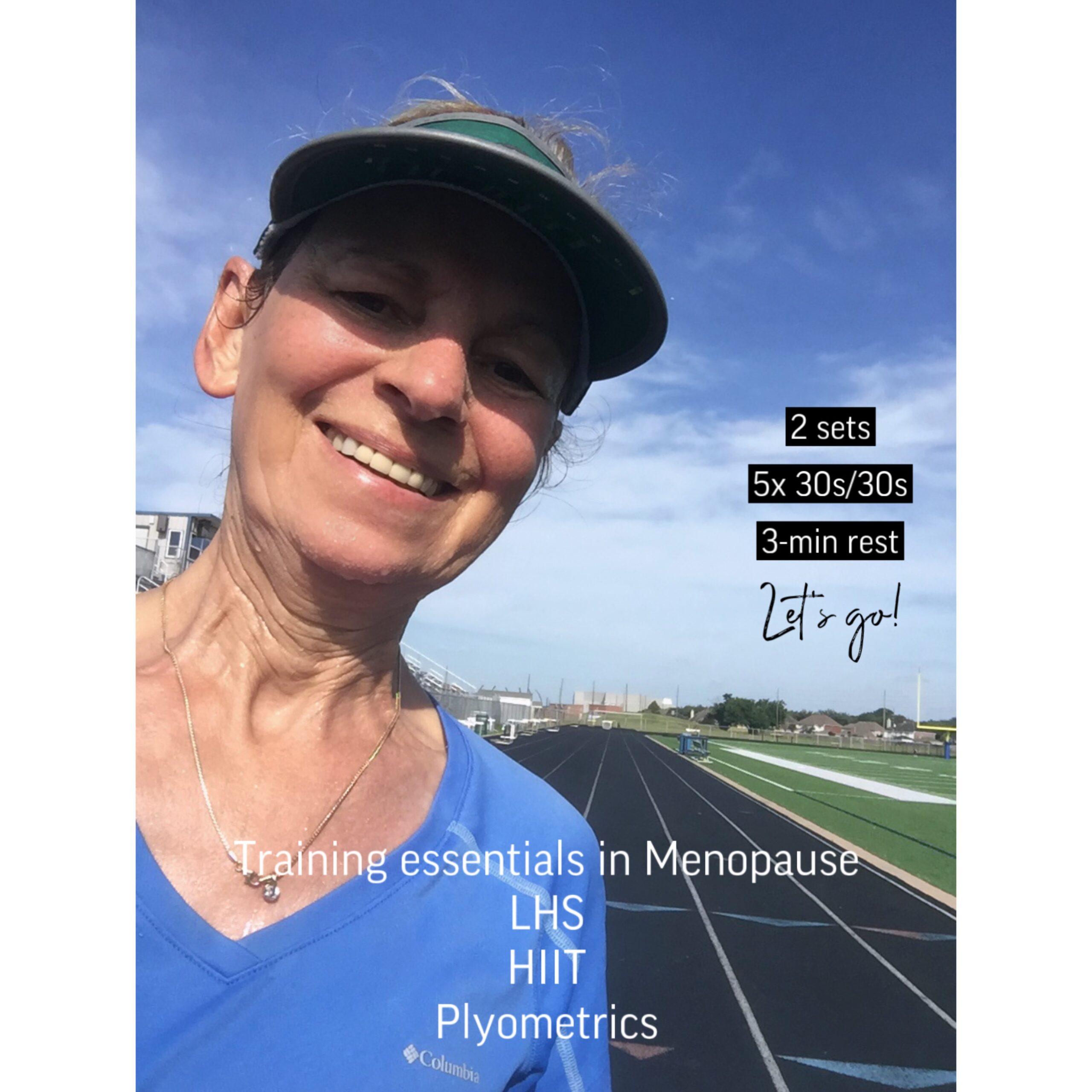
Reaching peri and post-menopause requires that we change the way we train. There are several reasons for this. For women who want to build lean mass, estrogen is like testosterone. When the body loses estrogen, it doesn’t work the same as before. Without that hormone stimulus, we need to look to external stimuli for growth. Long slow miles do not provide this stimulus. However, we can get it from intense workouts like LHS (lift heavy sh*t), HIIT or sprint interval training, and plyometrics.
Estrogen has general metabolic roles involved in actions on vascular function, lipid and carbohydrate metabolism, and bone mineralization. In post-menopause, estrogen is produced in several sites outside the sex organs. It acts locally, inducing changes in nearby cells, including breast, bone, vascular, and brain.
Adding LHS, HIIT, and plyometrics to your training regimen
Resistance training, HIIT, and Plyo each do something slightly different to help your body understand what it’s like not to have estrogen and progesterone driving so many responses. These exercises stimulate bone growth, insulin sensitivity, and neuromuscular contractions for power and speed. They also trigger the body to use and store carbohydrates with less reliance on storing fat, which estrogen used to support. So they are all equally important in peri and postmenopause.
How heavy should you lift? Load depends on your goals.
- For strength training – choose weights that let you train in a rep range of 1-6.
- If you want to build muscle – select weights that will enable you to lift in a rep range of 8-12.
- For muscular endurance – choose weights that let you train for at least 15 reps.
Endurance athletes
How do endurance athletes that typically need many long slow miles fit high-intensity work, resistance training, and plyo into their exercise regime? Ideally, you would do all three practices, depending on your health and fitness goals. If you must prioritize one, choose heavy resistance training with some jump work. These two work to give you more significant neuromuscular responses and a fast contraction, while plyo helps with both bone health and insulin control.
Periodized training and the need for more recovery time
Any program design will depend on your fitness, goals, job, stress, and health factors. Suppose your objective is optimal gains and recovery. In that case, one approach is to have two hard days, one easy, one moderate, another easy, and then hard days again. And in peri and postmenopause, you typically look at doing two-week load blocks and then a de-load week.
Often people spend too much time in that moderate intensity zone, keeping cortisol elevated for an extended period. Imbalanced cortisol can lead to cardiovascular issues, decreased blood vessel responses, insulin resistance, and other conditions.
In contrast, low-intensity exercise does not significantly increase cortisol levels. When examining corrections for plasma volume reduction and circadian factors, we see that low-intensity activity decreases circulating cortisol levels.
Women in the menopause demographic benefit most from polarized training—limiting that moderate, somewhat hard/somewhat easy zone and going super hard and then very easy to allow their body to recover and make adaptations.
In the two-week load phase, you polarize your training by applying specificity to your workouts. On weekdays you’ll have 2-3 hard days of heavy lifting, two hard days of high intensity, and plenty of recovery time – keeping hard days super hard and easy days leisurely. Then, if you’re an ultra-distance athlete, you have that one long slow endurance run/cycle/event on the weekend. Because, at this stage of life, long-slow distance does not create the same stimulus necessary to promote muscle growth. The strength and HIIT workouts make up for the cardio you would have done before, so you do not need to be afraid that the lower mileage will affect your performance. On the contrary, you will do better.
In the deload week, we aim to allow the body to recover fully. You’re using body weight or bands for mobility or activation exercises, working on technique, yoga, walking, and other activities in the recovery range. A marathon runner or cyclist would shorten their long run and keep cardio in the active recovery zone. An Olympic lifter uses lighter loads with attention on improving movement under load.
Know this:
Physical activity is one of the most critical components of a healthy lifestyle. Recent findings show that HRT fails to protect against heart disease, prompting a rethink of the role of exercise in preserving postmenopausal health.
To mitigate the rise of cortisol that comes with the menopause transition, take time for stress relief activities, like relaxing walks, yoga, tai chi, and meditation
RESOURCES
Resistance training: Shaw, Brandon S.; Gouveia, Monique; McIntyre, Shannon; Shaw, Ina. Anthropometric and cardiovascular responses to hypertrophic resistance training in postmenopausal women. Menopause, Volume 23, Number 11, November 2016, pp. 1176-1181(6). https://www.ingentaconnect.com/content/wk/gme/2016/00000023/00000011/art00005
Dupuit M, Maillard F, Pereira B, Marquezi ML, Lancha AH Jr, Boisseau N. Effect of high-intensity interval training (HIIT) on body composition in women before and after menopause: a meta-analysis. Exp Physiol. 2020 Sep;105(9):1470-1490. doi: 10.1113/EP088654. Epub 2020 Jul 21. PMID: 32613697.
Trained vs. untrained, in resistance training: Kemmler, W.K., D. Lauber, K. Engelke, and J. Weineck. Effects of single- vs. multiple-set resistance training on maximum strength and body composition in trained postmenopausal women. J. Strength Cond. Res. 18(4):000–000. 2004. http://www.ofz.unierlangen.de/pubs/efops_neu.pdf
Jump training for bone density: Smale et al.. Loading intensity of jumping exercises in postmenopausal women: Implications for osteogenic training. https://onlinelibrary.wiley.com/doi/abs/10.1002/tsm2.5
Exercise and circulating cortisol levels: moderate to high-intensity exercise increases cortisol levels. Remember that high-intensity workouts typically have a much shorter duration than moderate exercise, so although cortisol increases, recovery is quicker than the longer moderate-intensity workouts. https://pubmed.ncbi.nlm.nih.gov/18787373/

Comments are closed.